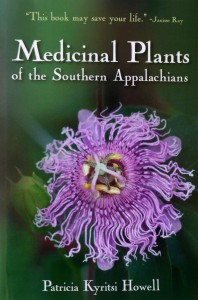Teaching experience: 25 plus years
Primary region: Southeastern U.S.
Website
Website: Wild Healing Herbs
Website pages include a schedule of classes at BotanoLogos School of Herbal Studies and “Appalachian Plants Field Studies” days, a Resources page with handouts and recipes, and “In the Appalachians Now” which documents plants to be found in the current season of the year.
Book
Medicinal Plants of the Southern Appalachians
Written by Patricia Kyritsi Howell
Copyright 2006
Published by BotanoLogos Books
- Chapter 1: How to Use This Book
- Chapter 2: The Simple Art of Medicine Making
- Chapter 3: The Medicinal Plants
- Bethroot–Trillium erectum
- Black Cohosh–Actaea racemosa
- Black Haw–Viburnum prunifolium
- Black Walnut–Juglans nigra
- Bloodroot–Sanguinaria canadensis
- Blue Cohosh–Caulophyllum thalictroides
- Boneset–Eupatorium perfoliatum
- Devil’s Walking Stick–Aralia spinosa
- Dogwood–Cornus florida
- Elder–Sambucus canadensis
- Evening Primrose–Oenothera biennis
- Fringetree–Chionanthus virginica
- Gentian–Gentiana clausa
- Ginseng, American–Panax quinquefolius
- Goldenrod–Solidago spp.
- Indian Pipe–Monotropa uniflora
- Jewelweed–Impatiens capensis
- Joe-pye-weed–Eupatorium purpureum
- Lobelia–Lobelia inflata
- Maidenhair Fern–Adiantum pedatum
- Mountain Mint–Pycnanthemum incanum
- Partridgeberry–Mitchella repens
- Passionflower–Passiflora incarnata
- Pipsissewa–Chimaphila umbellata
- Pleurisy Root–Asclepias tuberosa
- Rabbit Tobacco–Gnaphalium obtusifolium
- Red Root–Ceanothus americanus
- Sarsaparilla–Aralia nudicaulis
- Sassafras–Sassafras albidum
- Skullcap–Scutellaria lateriflora
- Solomon’s Seal–Polygonatum biflorum
- Spicebush–Lindera benzoin
- Stoneroot–Collinsonia canadensis
- Sumac–Rhus glabra
- Sweet Gum–Liquidambar styraciflua
- Sweetfern–Comptonia peregrina
- Turtlehead–Chelone glabra
- Virginia Snakeroot–Aristolochia serpentaria
- Wild Cherry–Prunus serotina
- Wild Geranium–Geranium maculatum
- Wild Ginger–Asarum canadense
- Wild Hydrangea–Hydrangea arborescens
- Wild Yam–Dioscorea villosa
- Witch Hazel–Hamamelis virginiana
- Yellowroot–Xanthorhiza simplicissima
Review: The chapter for each of the medicinal plants includes other common names for the plant, a description in words (no illustrations provided), typical habitat, key types of medicinal actions, the part(s) of the plant which are used, discussion of both the traditional and current uses of the plant, when to harvest, and the types of preparations and dosages to use with the plant. The supplementary material at the end of the book includes bloom and harvest calendars, a glossary, and a therapeutic index (among other items).
Medicinal Plants of the Southern Appalachians is a well-written and highly useful book for the forager of medicinal plants — particularly plants within the Southern Appalachians. Howell also inserted some simple “recipes” throughout the book. For example, there are recipes for “Lobelia Liniment,” “Sumac Berry Lemonade” and “Wild Cherry Cough Syrup.”
Available from: Wild Healing Herbs website, bookstores and online bookstores.

